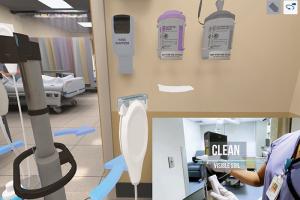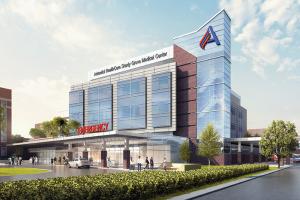Conference predicts what emergency department of the future will look like

Emergency medical professionals at the 2015 InnovatED exhibit.
The theme of this year's InnovatED exhibit at the 2015 Scientific Assembly focused on the emergency department of the future.
More than 60 companies gathered in Boston from Oct. 26-28 to demonstrate new technologies and devices to 6,500 attendees at the conference put on by the American College of Emergency Physicians (ACEP). Many of the demonstrations occurred in true-to-life emergency department (ED)displays, including three equipped trauma bays, giving attendees a simulated backdrop to examine current ED processes and think through future best practices.
Emergency medical professionals enacted "Code Blue" and "Code Black" scenarios, complete with doctors, ambulances and the latest clinical technologies. The conference featured three simulations each of active shooter scenarios and emergency treatment of stroke patients.
Sudave Mendiratta, M.D., FACEP, sits on the ACEP Education Committee and is co-chair of InnovatED and says the Code Blue and Code Black simulations were major highlights.
"These simulated codes gave us a glimpse into the future of emergency care, providing attendees with an example of how cutting edge tech can be applied to patient care," he says.
Other devices and technologies featured at the conference included a new simulation technology that gives clinicians a realistic environment in which to train for treatment processes and a software that offers a glimpse of what EDs will look like 50 years from today.
"The ED of the future is patient-centric, workflow-oriented, and scalable to multiple applications,"Mendiratta says. "The ED of the future is designed around the patient experience: comfortable seating, antimicrobial surfaces, minimal transitions, and integration of technology to augment — not replace — the physician-patient relationship."
Design and construction firms at the conference included HKS Inc., Huddy ED Design, Red Thread, FreemanWhite and Beck Group. Other facility-related vendors in attendance included such companies as Dupont Building Inc., IOA Healthcare Furniture and Steelcase Health.
Sharklet Technologies also attended, and Mendiratta says the company's product was a popular item among attendees. Sharklet has developed a surface designed to prevent bacterial transmission without using antimicrobials and added chemicals. The technology is based on the discovery that bacterial colonization is infrequent on shark skin and mimics a shark's exterior through millions of microscopic indentations arranged in a diamond pattern that inhibit bacteria's ability to attach, colonize and form biofilm.
Mendiratta says next year's conference will continue to focus on innovative products that allow emergency physicians to function in an integrated medical environment.
"When you bring the best minds in emergency medicine together with the latest advancements in medical technology and technological achievement, what you really have is the emergency department of the future," says ACEP President Jay Kaplan, M.D., FACEP. "Emergency departments are the front lines of health care, and InnovatED is an exciting place to see where emergency medicine is headed."




